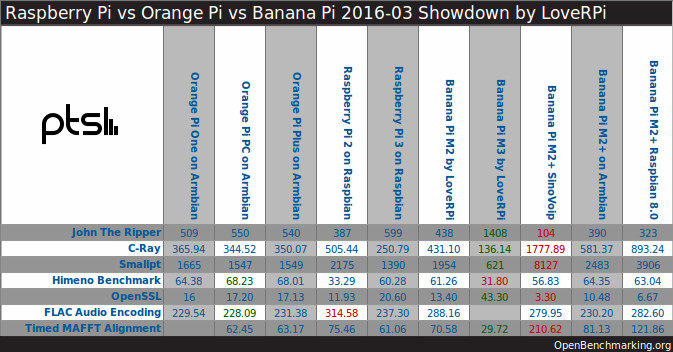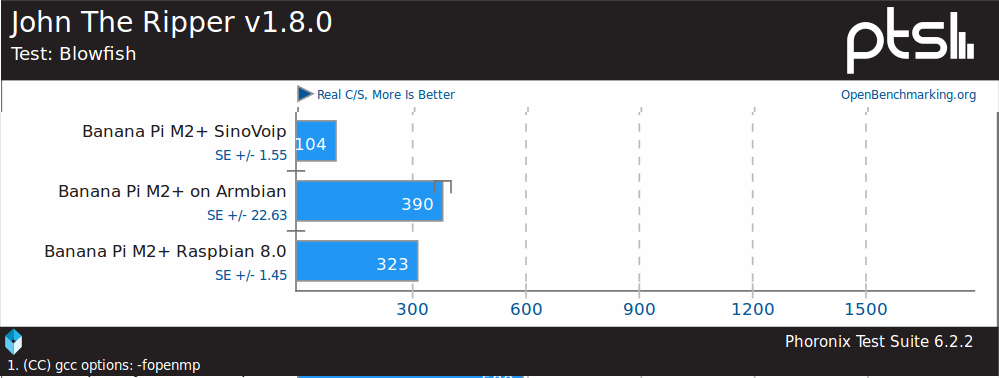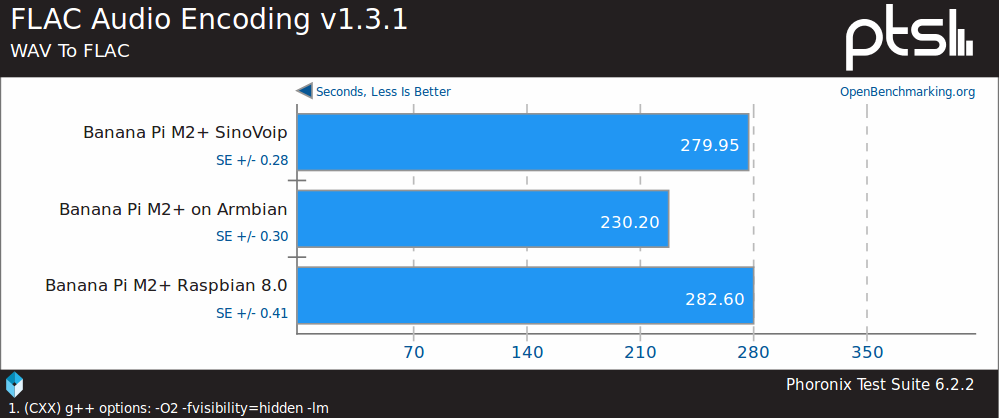The most common way to use a development board is to simply go to the manufacturer website, and download the images from there. They are the ones who made the hardware after all, and they should be the most knowledgeable about their platform. But it may not always be true as tkaiser found out when he ran some Phoronix benchmarks on Banana Pi M2+ (aka BPI M2+) board with SinoVoIP (the manufacturer), Armbian, and Raspbian images. The results speak for themselves.
 The last three columns are what is of interest here, and in some benchmark Banana Pi M2+ is about 3 times slower with SinoVoIP image compared to Armbian, while with others the performance is quite similar. John The Ripper password cracker benchmark shows a massive difference between distributions…
The last three columns are what is of interest here, and in some benchmark Banana Pi M2+ is about 3 times slower with SinoVoIP image compared to Armbian, while with others the performance is quite similar. John The Ripper password cracker benchmark shows a massive difference between distributions…

… while FLAC audio encoding not so much.

So what’s going on here? First Jon the Ripper is a multi-threaded applications, while FLAC audio encoding works mostly on one thread, so SinoVoIP image does not seem to be negatively impacted by tasks using a single core. More clues comes with one comment, after SinoVoIP released a new Android 4.4 firmware on April 11:
the maximum clockspeed for bpi m+ is just 1Ghz not 1.2 as advertised and cpu cores stops after full load
So the massive performance degradation in multicore benchmarks appears to be related to the CPU throttling implementation, with the SinoVoIP image simply killing cores instead of decreasing frequency in order to manage the CPU temperature. That means multi-threaded tasks may run on a single core after a short time with SinoVoIP image, instead of the 4 cores on Allwinner H3 processor on Armbian and Raspbian images. The small performance difference is also explained by the lower maximum CPU frequency, as Allwinner H3 is rated to run at 1.2 GHz, but SinoVoIP decreased that to about 1 GHz.
tkaiser explains further:
Unfortunately SinoVoip again tries very hard to ignore any bug fixes or improvements which will lead to the BPi M2+ being the slowest H3 board ever. Their THS settings limit the CPU clockspeed to 1008 MHz (compare with the 1.2GHz they advertise with) and to killed CPU cores instead of lowering the CPU clockspeed. So chances are great that you end up with H3 running just at 1008 MHz and only one active CPU core after running heavy stuff on the board.
While Armbian already takes special precautions for the M2+ to bring back killed CPU cores and implements sane throttling (240MHz to 1200MHz) SinoVoip chose to ignore all of this.
What’s even more frustrating is that, as I understand it, all what is needed are some modifications of script.bin (aka FEX file) – Allwinner configuration files -, and specifically the cooler_table and dvfs_table sections of the file. Hopefully, SinoVoIP, and potentially other manufacturers, will read this post so that they can provide optimized images for their Allwinner boards and devices. In the meantime, you’d be better served by using Armbian images, unless you need to run Android, although simply replacing script.bin should help.

Jean-Luc started CNX Software in 2010 as a part-time endeavor, before quitting his job as a software engineering manager, and starting to write daily news, and reviews full time later in 2011.
Support CNX Software! Donate via cryptocurrencies, become a Patron on Patreon, or purchase goods on Amazon or Aliexpress




